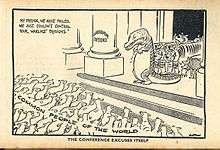World Disarmament Conference
The Conference for the Reduction and Limitation of Armaments of 1932–1934 (also known as the World Disarmament Conference or the Geneva Disarmament Conference) was a failed effort by member states of the League of Nations, together with the United States, to accomplish disarmament. It took place in the city of Geneva, Switzerland, from 1932 to 1934.[1]

Background
The first effort at international arms limitation was made at the Hague Conferences of 1901 and 1907, which had failed in their primary objective. Although many contemporary commentators and Article 231 of the Treaty of Versailles blamed the outbreak of the First World War on the war guilt of Germany, historians writing in the 1930s began to emphasize the quick arms race preceding 1914. Also, all the major powers except the United States had committed themselves to disarmament in both the Treaty of Versailles and the Covenant of the League of Nations. A substantial international nongovernmental campaign to promote disarmament also developed in the 1920s and the early 1930s.
A preparatory commission was initiated by the League in 1925. By 1931, there was sufficient support to hold a conference, which duly began under the chairmanship of former British Foreign Secretary Arthur Henderson. The motivation behind the talks can be summed up by an extract from the message that US President Franklin Roosevelt sent to the conference: "If all nations will agree wholly to eliminate from possession and use the weapons which make possible a successful attack, defences automatically will become impregnable and the frontiers and independence of every nation will become secure."[2] The League's failure to ensure the success of the talks impacted the likelihood of a second major European conflict.
Negotiations
The talks were beset by a number of difficulties from the outset. Germany immediately demanded to be allowed military equality or it would leave. However, the French were equally insistent that German military inferiority was their only insurance from a future conflict as serious as they had endured in the First World War. Britain and the US were unprepared to offer the additional security commitments that France requested in exchange for limitation of French armaments. After ten months of negotiations, France, Britain and Italy announced that Germany and the other states disarmed by the Versailles Treaty should be insured equality in a system that give security to all nations."[3] The parties could not agree on what constituted "offensive" and "defensive" weapons.
The talks broke down, and Hitler withdrew Germany from both the Conference and the League of Nations on the 14th of October 1933. The 1930s had proved far too self-interested an international period to accommodate multilateral action in favour of peace.[4]
References
- Philip John Noel-Baker, First World Disarmament Conference and Why It Failed (1979)
- United States Department of State, Peace and War: United States Foreign Policy 1931-1941 (United States Government Printing Office, Washington, 1943) pp. 10
- Davies, 2004.
- Frederick L. Schuman, Europe On The Eve 1933-1939 (1939) pp 28-54. online.
Sources
Further reading
- Fanning, Richard Ward, Peace and Disarmament, Naval Rivalry and Arms Control, 1922-1933, The University Press of Kentucky, Lexington, 1995.
- Kitching, Carolyn, Britain and the Geneva Disarmament Conference, Palgrave MacMillan, Houndmills, New York, 2003
- Steiner, Zara. The Triumph of the Dark: European International History 1933-1939 (2011) pp 9-61.
- Temperley, A.C. The Whispering Gallery Of Europe (1938), highly influential account online